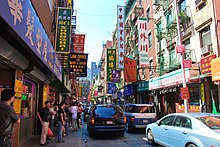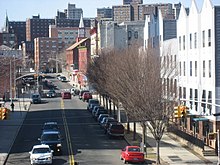
The Bronx is a borough of New York City, coextensive with Bronx County, in the U.S. state of New York. It is south of Westchester County; north and east of the New York City borough of Manhattan, across the Harlem River; and north of the New York City borough of Queens, across the East River. The Bronx is the only New York City borough not primarily located on an island. The Bronx has a land area of 42 square miles (109 km2) and a population of 1,472,654 in the 2020 census. If each borough were ranked as a city, the Bronx would rank as the ninth-most-populous in the U.S. Of the five boroughs, it has the fourth-largest area, fourth-highest population, and third-highest population density. The population density of the Bronx was 32,718.7 inhabitants per square mile (12,632.8/km2) in 2022, the third-highest population density of any county in the United States, behind Manhattan and Brooklyn. With a population that is 54.8% Hispanic as of 2020, it is the only majority-Hispanic county in the Northeastern United States and the fourth-most-populous nationwide.

Manhattan is the most densely populated and geographically smallest of the five boroughs of New York City. The borough is coextensive with New York County, the smallest county by geographical area in the U.S. state of New York. Located almost entirely on Manhattan Island near the southern tip of the state, Manhattan constitutes the center of the Northeast megalopolis and the urban core of the New York metropolitan area. Manhattan serves as New York City's economic and administrative center and has been described as the cultural, financial, media, and entertainment capital of the world.

Queens is a borough of New York City, coextensive with Queens County, in the U.S. state of New York. Located at the western end of Long Island, it is the largest of the five New York City boroughs by area. It is bordered by the borough of Brooklyn and by Nassau County to its east, and shares maritime borders with the boroughs of Manhattan, the Bronx, and Staten Island, as well as with New Jersey. Queens is the most linguistically and ethnically diverse place on Earth.

Brooklyn is a borough of New York City. Located on the westernmost end of Long Island, it is coextensive with Kings County in the U.S. state of New York. With 2,736,074 residents as of the 2020 United States census, Kings County is the most populous of the five boroughs of New York City and the most populous county in the State of New York. The population density of Brooklyn was 37,339.9 inhabitants per square mile (14,417.0/km2) in 2022, making it the second-most-densely-populated county in the United States, behind Manhattan, and it had the ninth-highest population of any county nationwide. Were Brooklyn still an independent city, it would be the fourth most populous in the U.S. after the rest of New York City, Los Angeles, and Chicago.

Marble Hill is the northernmost neighborhood in the New York City borough of Manhattan. Although once part of Manhattan Island, it has been cut off from the island since 1895. The Bronx surrounds the neighborhood to the west, north, and east, while the Harlem River is its southern border.

The City of Greater New York was the term used by many politicians and scholars for the expanded City of New York created on January 1, 1898, by consolidating the existing City of New York with Brooklyn, western Queens County, and Staten Island. The section of the Bronx west of the Bronx River had been annexed to the City and County of New York in 1874 and was known as the Annexed District. The section of the Bronx east of the Bronx River had been annexed to the City and County of New York in 1895.

Area codes 212, 646, and 332 are area codes in the North American Numbering Plan (NANP) for most of the borough of Manhattan in New York City. By area, it is one of the smallest numbering plan areas (NPAs). The three area codes form an overlay numbering plan, and are also overlaid by area code 917 of a numbering plan area that comprises the entirety of New York City. Area code 212 is the original code assigned for all of the city in 1947. After a restriction of 212 to just Manhattan in 1985, area code 646 was assigned to Manhattan in 1999. In 2015, area code 332 was also added to the Manhattan overlay.

Area code 917 is a telephone area code in the North American Numbering Plan for the five boroughs of New York City: The Bronx, Brooklyn, Manhattan, Queens, and Staten Island. It is an overlay code to all numbering plan areas (NPAs) in the city, and was intended to serve cellular, pager, and voicemail applications in the city, a restriction that was subsequently ruled impermissible by the Federal Communications Commission (FCC) while grandfathering that use in New York City. Area code 917 is also assigned to landlines predominantly in Manhattan, to relieve the shortage of numbers there.

New York City is a large and ethnically diverse metropolis. It is the largest city in the United States with a long history of international immigration. The New York region continues to be by far the leading metropolitan gateway for legal immigrants admitted into the United States. The city is the geographical and demographic center of both the Northeast megalopolis and the New York metropolitan area, the largest metropolitan area in the U.S. by both population and urban area. With over 20.1 million people in its metropolitan statistical area and 23.5 million in its combined statistical area as of 2020, New York City is one of the world's most populous megacities.

Area codes 718, 347, and 929 are telephone area codes in the North American Numbering Plan (NANP) for the New York City boroughs of the Bronx, Brooklyn, Queens, and Staten Island, as well as the Marble Hill section of Manhattan. They are part of a larger overlay plan with area code 917, which comprises all of New York City.

A borough in some U.S. states is a unit of local government or other administrative division below the level of the state. The term is currently used in six states:
The borough presidents are the chief executives of the five boroughs of New York City. For most of the city's history, the office exercised significant executive powers within each borough, and the five borough presidents also sat on the New York City Board of Estimate. Since 1990, the borough presidents have been stripped of a majority of their powers in the government of New York City.

The geography of New York City is characterized by its coastal position at the meeting of the Hudson River and the Atlantic Ocean in a naturally sheltered harbor. The city's geography, with its scarce availability of land, is a contributing factor in making New York the most densely populated major city in the United States. Environmental issues are chiefly concerned with managing this density, which also explains why New York is among the most energy-efficient and least automobile-dependent cities in the United States. The city's climate is temperate.

Since its founding in 1625 by Dutch traders as New Amsterdam, New York City has been a major destination for immigrants of many nationalities who have formed ethnic enclaves, neighborhoods dominated by one ethnicity. Freed African American slaves also moved to New York City in the Great Migration and the later Second Great Migration and formed ethnic enclaves. These neighborhoods are set apart from the main city by differences such as food, goods for sale, or even language. Ethnic enclaves provide inhabitants security in work and social opportunities, but limit economic opportunities, do not encourage the development of English speaking, and keep immigrants in their own culture.

MTA Regional Bus Operations (RBO) is the surface transit division of the Metropolitan Transportation Authority (MTA). It was created in 2008 to consolidate all bus operations in New York City operated by the MTA. As of February 2018, MTA Regional Bus Operations runs 234 local routes, 71 express routes, and 20 Select Bus Service routes. Its fleet of 5,840 buses is the largest municipal bus fleet in the United States and operates 24/7. In 2023, the system had a ridership of 730,924,600, or about 2,309,600 per weekday as of the fourth quarter of 2023.

The 2013 elections for borough presidents were held on November 5, 2013, and coincided with elections for Mayor, Public Advocate, Comptroller, and members of the New York City Council. Primary elections were held on September 10, 2013.





















